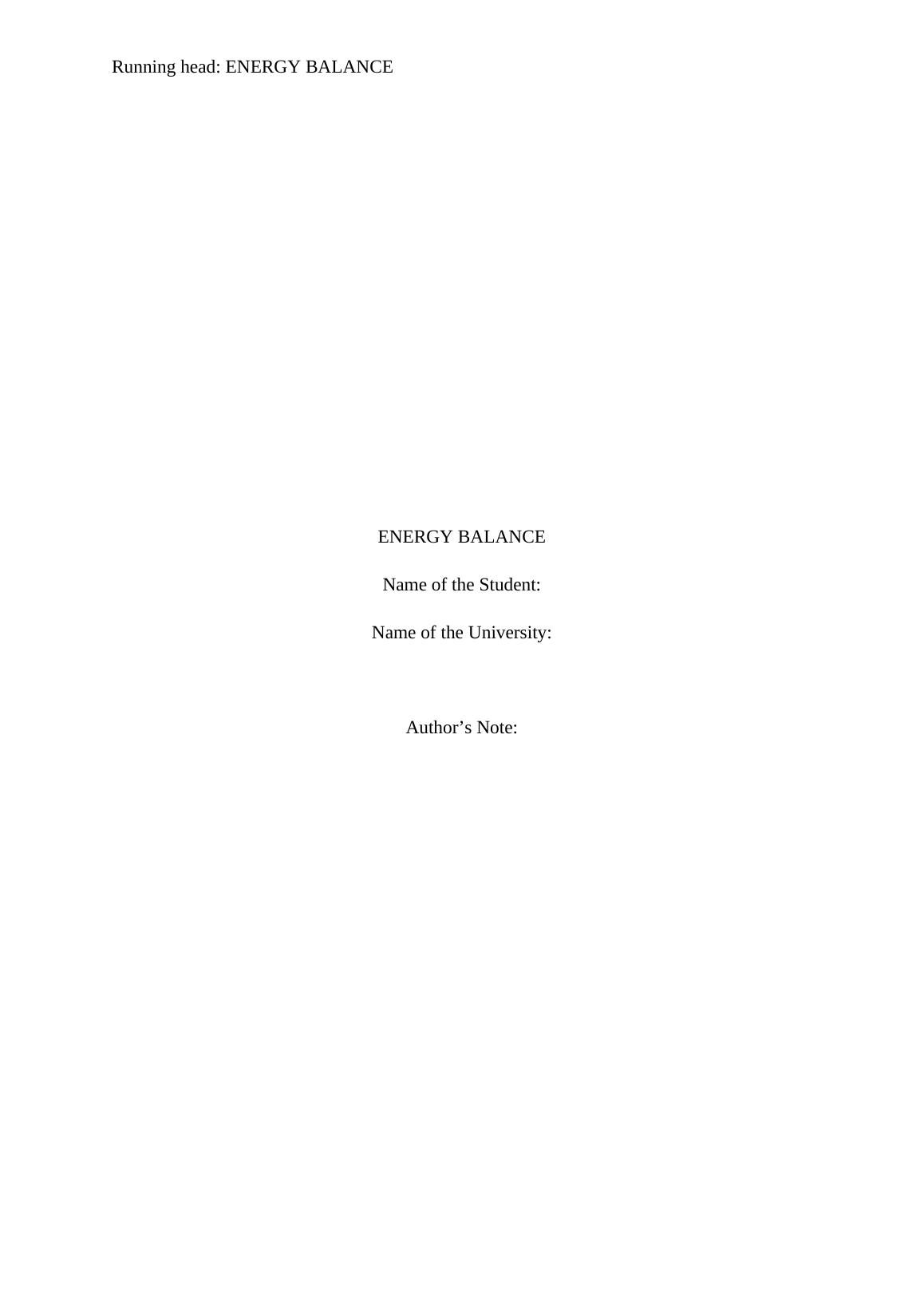Energy Balance | Assignment
Added on 2022-09-09
6 Pages1195 Words20 Views
Running head: ENERGY BALANCE
ENERGY BALANCE
Name of the Student:
Name of the University:
Author’s Note:
ENERGY BALANCE
Name of the Student:
Name of the University:
Author’s Note:

1ENERGY BALANCE
Table of Contents
Introduction................................................................................................................................2
Reference....................................................................................................................................5
Table of Figures
Figure 1: BMI Chart...................................................................................................................3
Table of Contents
Introduction................................................................................................................................2
Reference....................................................................................................................................5
Table of Figures
Figure 1: BMI Chart...................................................................................................................3

2ENERGY BALANCE
Introduction
Energy balance refers to the balance between the energy intake as well as the energy
intake. Moreover, it helps to balance the calories taken by food consumption compared to the
calories burnt by physical activity (Romieu et al. 2017).
Energy balance is important to maintain the BMI range to normal. Due to insufficient
energy balance, the person may suffer from undernutrition or overnutrition. When energy
intake is more than energy expenditure, one can gain a positive energy balance; as a result
weight gain occurs (Caldwell, Eaton and Konner 2019). On the other hand, if the energy
intake is less than energy expenditure, one can have negative energy balance; as a result,
weight loss occurs (Romieu et al. 2017). Both undernutrition and overnutrition are types of
malnutrition. Positive energy balance causes over nutrition that is when one consumes more
nutrients than the daily need every day. On the other hand, negative energy balance causes
undernutrition that is when, one consumes fewer nutrients than the daily need every day.
1st law of thermodynamic is the law of energy conversion. There are two types of
energy conversion, which includes heat and thermodynamic work. According to the first law
of thermodynamics, of the isolated system, the total energy is always constant (Wang 2020).
Energy transforms from one state to another, but it cannot be destroyed or created; all energy
transformed to heat at the end. The formula of the first law is ∆U= Q-W; where Q is supplied
energy quantity and W is the amount of thermodynamic activity and U refers to change in
internal energy of the closed system.
BMI or Body Mass Index refers to the value that is derived from the weight (mass)
and the height of an individual. It is a key index to relate weight with height. The ‘BMI=
weight in kg/ height in m2’. BMI can indicate whether an individual is underweight; normal
weight; overweight and obese. WHO has provided a standard BMI chart to record the obesity
statistics from early 1980 (WHO 2020).
Introduction
Energy balance refers to the balance between the energy intake as well as the energy
intake. Moreover, it helps to balance the calories taken by food consumption compared to the
calories burnt by physical activity (Romieu et al. 2017).
Energy balance is important to maintain the BMI range to normal. Due to insufficient
energy balance, the person may suffer from undernutrition or overnutrition. When energy
intake is more than energy expenditure, one can gain a positive energy balance; as a result
weight gain occurs (Caldwell, Eaton and Konner 2019). On the other hand, if the energy
intake is less than energy expenditure, one can have negative energy balance; as a result,
weight loss occurs (Romieu et al. 2017). Both undernutrition and overnutrition are types of
malnutrition. Positive energy balance causes over nutrition that is when one consumes more
nutrients than the daily need every day. On the other hand, negative energy balance causes
undernutrition that is when, one consumes fewer nutrients than the daily need every day.
1st law of thermodynamic is the law of energy conversion. There are two types of
energy conversion, which includes heat and thermodynamic work. According to the first law
of thermodynamics, of the isolated system, the total energy is always constant (Wang 2020).
Energy transforms from one state to another, but it cannot be destroyed or created; all energy
transformed to heat at the end. The formula of the first law is ∆U= Q-W; where Q is supplied
energy quantity and W is the amount of thermodynamic activity and U refers to change in
internal energy of the closed system.
BMI or Body Mass Index refers to the value that is derived from the weight (mass)
and the height of an individual. It is a key index to relate weight with height. The ‘BMI=
weight in kg/ height in m2’. BMI can indicate whether an individual is underweight; normal
weight; overweight and obese. WHO has provided a standard BMI chart to record the obesity
statistics from early 1980 (WHO 2020).

End of preview
Want to access all the pages? Upload your documents or become a member.
Related Documents
Obesity: Prevalence, Causes, Risk Factors and Interventionslg...
|7
|1827
|314
